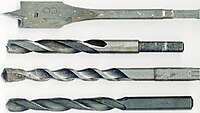
Photo from wikipedia
Abstract The interaction mechanism between the tool flank wear and the cutting force, in milling Ti-6Al-4V, is of significance for its further development. However, the relationship between the tool flank… Click to show full abstract
Abstract The interaction mechanism between the tool flank wear and the cutting force, in milling Ti-6Al-4V, is of significance for its further development. However, the relationship between the tool flank wear and the cutting force should be further investigated under ultrasonic-assisted milling. In this study, the longitudinal-torsional ultrasonic-assisted milling (LTUAM) Ti-6Al-4V in dry cutting was evaluated by comparing with conventional milling (CM). With the consideration of the ultrasonic vibration on the chip flow angle, a novel cutting force model in terms of the tool flank wear was developed by discretizing the side edge to apply the oblique model. Wherein the stress evolution both on the shear plane and the flank plane was analyzed, as well as the swinging range of chip flow angle resulted from ultrasonic vibration. In addition, the coefficients of the cutting force were calibrated through the mechanical method. The model could predict the cutting force evolution with different flank wear bandwidth (VB), and optimize the machining parameters. The experimental results indicated the errors between the model and the test were 19.1 % and 12.9 % in the feed (x) and the normal (y) direction of the tool coordinate system (o-xyz), respectively. Through time-frequency transformation, the behavior of the cutting force both in CM and LTUAM was further explained. Besides, the growing amplitude was beneficial to restrain the flank wear apart from the overgrowing amplitude, while the growing helix angles resulted in the serious tool flank wear in LTUAM. For the machined surface texture, the cutter scratches parallel to the feed direction dominated the machined surface in CM while the LTUAM surface featured by the order wave textures.
Journal Title: Journal of Materials Processing Technology
Year Published: 2021
Link to full text (if available)
Share on Social Media: Sign Up to like & get
recommendations!